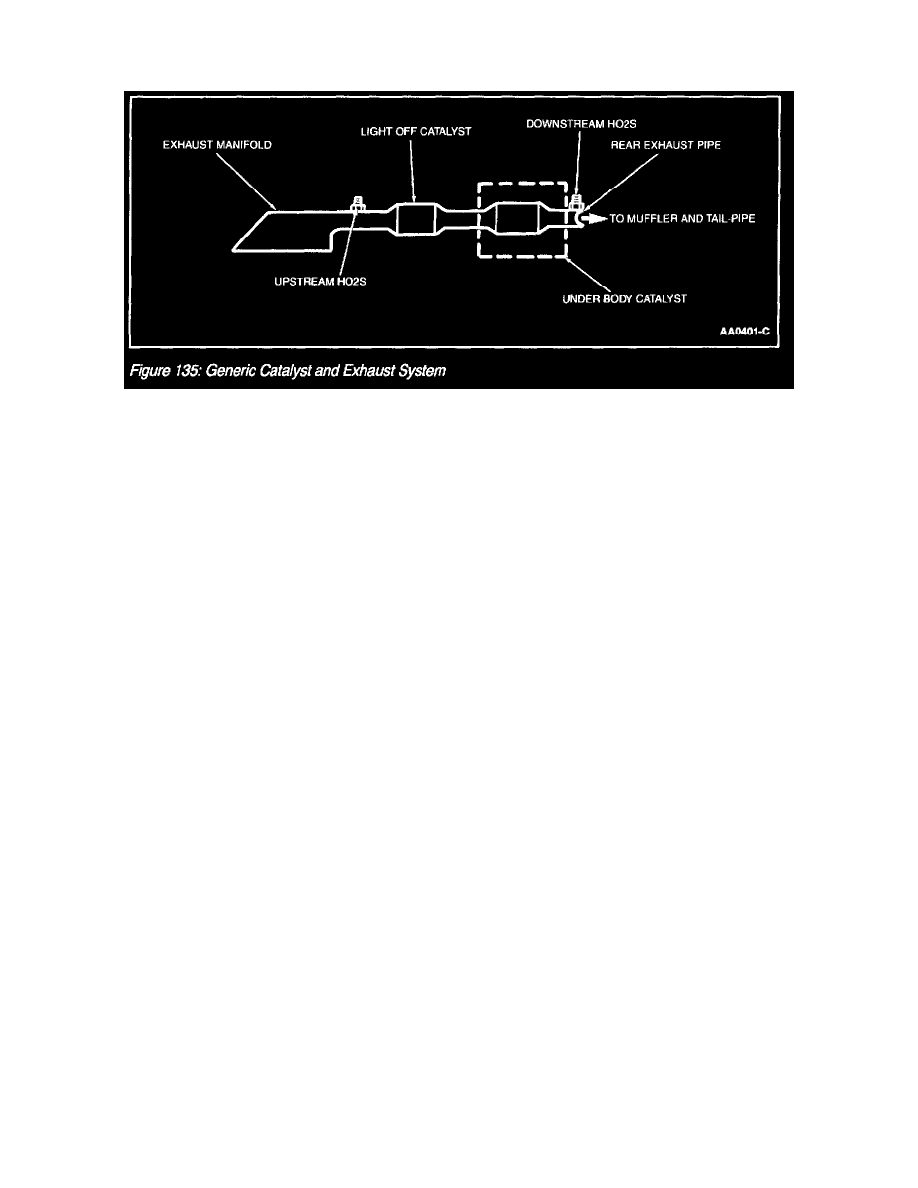Crown Victoria V8-4.6L VIN W (2000)

Catalytic Converter: Description and Operation
Overview
Generic Catalyst and Exhaust System
The Catalytic Converter and Exhaust Systems work together to control the release of harmful engine exhaust emissions into the atmosphere. The engine
exhaust gas consists mainly of Nitrogen (N), Carbon Dioxide (CO2) and Water Vapor (H2O). However, it also contains Carbon Monoxide (CO),
Oxides Of Nitrogen (NOx), Hydrogen (H), and various unburned Hydrocarbons (HCs). CO, NOx, and HCs are major air pollutants, and their emission
into the atmosphere must be controlled.
The exhaust system generally consists of an exhaust manifold, front exhaust pipe, upstream Heated Oxygen Sensor (HO2S), rear exhaust pipe,
downstream HO2S, a muffler and an exhaust tailpipe. The catalytic converter is installed between the front and rear exhaust pipes. Catalytic converter
efficiency is monitored by the On Board Diagnostic (OBD II) system. (Refer to OBD II Monitors to Catalyst Efficiency Monitor-Federal Test Procedure
for specific information.)
Catalytic Converter
A catalyst is a material that remains unchanged when it initiates and increases the speed of a chemical reaction. A catalyst will also enable a chemical
reaction to occur at a lower temperature. The concentration of exhaust gas products released to the atmosphere must be controlled. The catalytic
converter assists in this task. It contains a catalyst in the form of a specially treated honeycomb structure saturated with catalytically active precious
metals. As the exhaust gases come in contact with the catalyst, they are changed into mostly harmless products. The catalyst initiates and speeds up heat
producing chemical reactions of the exhaust gas components so they are used up as much as possible.
Exhaust System
The purpose of the exhaust system is to convey engine emissions from the exhaust manifold to the atmosphere. Engine exhaust emissions are directed
from the engine exhaust manifold to the catalytic converter through the front exhaust pipe. An HO2S is mounted on the front exhaust pipe before the
catalyst. The catalytic converter reduces the concentration of Carbon Monoxide (CO), unburned Hydrocarbons (HCs) and Oxides Of Nitrogen (NOx) in
the exhaust emissions to an acceptable level. The reduced exhaust emissions are directed from the catalytic converter to a muffler through the rear
exhaust pipe. Another HO2S is mounted on the rear exhaust pipe. Lastly, the exhaust emissions are directed to the atmosphere through an exhaust
tailpipe.
HARDWARE
The downstream HO2S may be located after the light off catalyst or underbody catalyst. The underbody catalyst may be in-line with the light off catalyst,
or the underbody catalyst may be common to two light off catalysts, forming a "Y" pipe configuration. For an exact configuration of the catalyst and
exhaust system, refer to Exhaust System.
Three Way Catalytic Converter
The Three Way Catalytic (TWC) converter contains either Platinum (Pt) and Rhodium (Rh) or Palladium (Pd) and Rhodium (Rh). The TWC converter
catalyzes the oxidation reactions of unburned HCs and CO and the reduction reaction of NOx. The three-way conversion can br brst accomplished by
always operating the engine air fuel/ratio at or close to stoichiometry.
Exhaust Manifold/Runners
The exhaust manifold runners collect exhaust gases from engine cylinders. The number of exhaust manifolds and exhaust manifold runners depends on
